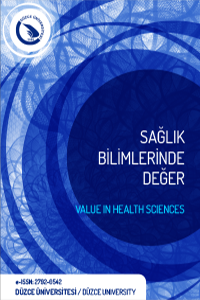COVID-19 Pandemisinden Önce ve Sonra Çekilen Toraks Bilgisayarlı Tomografilerin Analizi
Acil Servis, torasik bilgisayarlı tomografi, COVID-19, ionizan radyasyon
The Analysis of Thoracic Computed Tomography before and after COVID-19 Pandemic
___
- İncesu E, Beylik U, Küçükkendirci H. The problem of re-admission to emergency services: a case study for a state hospital emergency service in Turkey. Akademik Bakış International Refereed Journal of Social Sciences. 2016; (53): 1-13.
- Karpuz Ç. Acil servise başvuran hastalara çekilen toraks bilgisayarlı tomografilerin değerlendirilmesinde acil tıp uzmanlık öğrencilerinin tomografileri yorumlamadaki doğruluk ve güvenilirlik derecelerinin araştırılması [Uzmanlık Tezi]. Bursa: Uludağ Üniversitesi; 2018.
- Satıcı C, Kabalak PA, Yılmaz U. Lung cancer and COVID-19: need to know principles for chest specialists. Eurasian Journal of Pulmonology. 2020; Additional issue review: 118-27.
- Balbay EG, Safçı S, Çakıroğlu EB, Şafak AA. Are we requesting computed thoracic tomography more than needed? Abant Medical Journal. 2015; 4(1): 6-10
- Perelas A, Dimou A, Saenz A, Rhee JH, Teerapuncharoen K, Rowden A, et al. Incidental findings on computed tomography angiography in patients evaluated for pulmonary embolism. Annals of the American Thoracic Society. 2015; 12(5): 689-95.
- Shi H, Han X, Jiang N, Cao Y, Alwalid O, Gu J, et al. Radiological findings from 81 patients with COVID-19 pneumonia in Wuhan, China: a descriptive study. The Lancet Infectious Diseases. 2020; 20(4): 425-34.
- Yoon SH, Lee KH, Kim JY, Lee YK, Ko H, Kim KH, et al. Chest radiographic and CT findings of the 2019 novel coronavirus disease (COVID-19): analysis of nine patients treated in Korea. Korean Journal of Radiology. 2020; 21(4): 494-500.
- Caruso D, Zerunian M, Polici M, Pucciarelli F, Polidori T, Rucci C, et al. Chest CT features of COVID-19 in Rome, Italy. Radiology. 2020; 296(2): E79-85.
- Ai T, Yang Z, Hou H, Zhan C, Chen C, Lv W, et al. Correlation of chest CT and RT-PCR testing in coronavirus disease 2019 (COVID-19) in China: a report of 1014 cases. Radiology. 2020; 296(2): E32-40.
- Inui S, Fujikawa A, Jitsu M, Kunishima N, Wanatabe S, Suziki Y, et al. Chest CT findings in cases from the cruise ship “Diamond Princess” with Coronavirus disease 2019 (COVID-19). Radiology: Cardiothoracic Imaging. 2020; 2(2): e200110.
- Zhao W, Zhong Z, Xie X, Yu Q, Liu J. Relation between chest CT findings and clinical conditions of coronavirus disease (COVID-19) pneumonia: a multicenter study. American Journal of Roentgenology. 2020; 214(5): 1072-7.
- McCunney RJ, Li J. Radiation risks in lung cancer screening programs. Chest. 2014; 145(3): 618-24. Davy S, Byrne M, Roche C, Glynn C, McCarthy P. Alternative diagnoses and incidental findings on CTPA. European Congress of Radiology; 2018 Feb 28– Mar 4; Austria.
- Hu JJ, Smith TR, Miller MS, Lohman K, Case LD. Genetic regulation of ionizing radiation sensitivity and breast cancer risk. Environmental and Molecular Mutagenesis. 2002; 39(2-3): 208-15.
- Wong HYF, Lam HYS, Fong AHT, Leung ST, Chin TWY, Lui MMS, et al. Frequency and distribution of chest radiographic findings in COVID-19 positive patients. Radiology. 2020; 296(2): E72-8.
- Kanne JP, Little BP, Chung JH, Elicker BM, Ketai LH. Essentials for radiologists on COVID-19: an update—radiology scientific expert panel. 2020; 296(2): E113-4.
- Bernheim A, Mei X, Huang M, Yang Y, Fayad ZA, Zhang N, et al. Chest CT findings in coronavirus disease-19 (COVID-19): relationship to duration of infection. Radiology. 2020; 295(3): 685-91.
- Salehi S, Abedi A, Balakrishnan S, Gholamrezanezhad A. Coronavirus disease 2019 (COVID-19): a systematic review of imaging findings in 919 patients. American Journal of Roentgenology. 2020; 215(1): 1-7.
- Yayın Aralığı: Yılda 3 Sayı
- Başlangıç: 2022
- Yayıncı: Düzce Üniversitesi
İlker ÇOLAK, Zehra Betül KARAKOÇ, Emel METE, Tuğçe ÖZEN, Güven BULUT, Tuğba KURU ÇOLAK
Ciddi Acil Tanılarıyla Karışan Nadir Bir Durum: Kist Hidatik Rüptürü, Bir Olgu Sunumu
Bir Toplum Ruh Sağlığı Merkezindeki Hastalarda Tıbbi Tedaviye Uyumun İncelenmesi
Ayakta Sıradışı bir Preaksiyel Polidaktili Olgusu; Vaka Sunumu
Banu TURHAN, Yunus Emre BULUM, Mehmet ARICAN, Yalçın TURHAN
Gözde EMİNOĞLU, Mehmet GÜNEL, Muhammed AKÇAKOCA, Şengül CANGÜR, Cihadiye ÖZTÜRK
Ratlarda Amiloid Beta1-42 İle Oluşturulan Deneysel Alzheimer Modelinde Tiyol Disülfit Homeostazisi
COVID-19 Pandemisinden Önce ve Sonra Çekilen Toraks Bilgisayarlı Tomografilerin Analizi
Hasan Baki ALTINSOY, Mustafa BOĞAN
Özel Bakım Gereksinimi Olan Bireylerde Ağız-Diş Bulgularının Değerlendirilmesi
Yelda KASIMOĞLU, Cansu AKAY, Özgecan ÇAYNAK, Zeynep AYTEPE, Mine KORUYUCU
Gebe Kadınlarda Toxoplasma, Rubella ve Sitomegalovirüs Serum Antikorlarının Sıklığı
